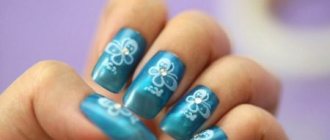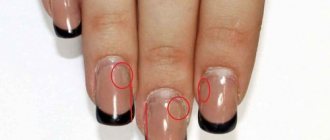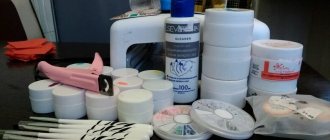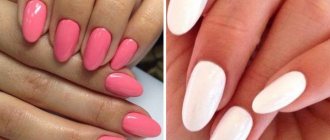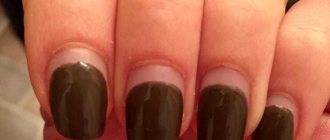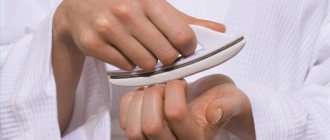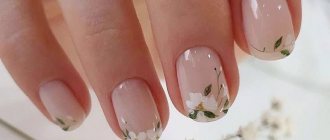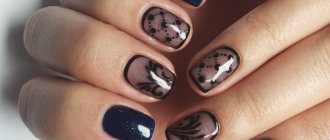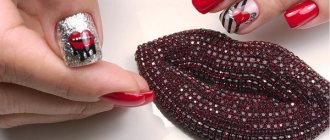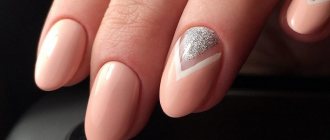Causes of inflammation
What is the cuticle? It is essentially a thin layer of skin that is located at the bottom of each nail. The main function of the cuticle is to protect the nails from dirt and bacteria. For some reasons, the cuticle becomes inflamed:
- This occurs due to fungal diseases.
- The cause is burrs that are not removed correctly. To avoid inflammation, it is better to use nail clippers.
- As a result of improper cuticle care. It subsequently becomes rougher, cracks, and becomes dry.
- Often the reason is an allergy to something: nail polish or hand cream.
- Inflammation of the cuticle on the finger can be caused by blows, bruises and other mechanical damage.
- This list includes ingrown toenails.
- Inflammation of the cuticle after a manicure is a common problem.
- Often, household chemicals have a detrimental effect on the skin of your hands.
- The habit of biting nails also provokes this unpleasant process.
The danger of manicure
The most popular salon procedure is manicure. This fact is confirmed by the growing number of nail bars located in shopping centers. Women want to quickly get their hands in order by popping in for a manicure during their lunch break or shopping for groceries for the home.
Hygienic cleaning of nails in a salon is not only the most popular, but also the most dangerous procedure. Venereologists and dermatologists regularly treat pathologies that develop as a result of infection after a manicure. The danger of contracting hepatitis and HIV infection here is quite real if the master does not carry out a set of sterilization measures. As numerous checks have shown, many workers of even the most elite salons are guilty of this.
Cases of HIV infection after going to a beauty salon are truly extremely rare. But this is not the merit of the masters. This virus dies quickly in the open air. But hepatitis is very stable and it is quite possible to become infected with it.
Most often, the nail plate is affected by bacterial infections and fungi. Through the cuticle injured during the procedure, pyogenic cocci can enter the wound. The infection begins to develop very quickly. The process is accompanied by symptoms such as swelling and pain. This may lead to the development of complications.
Patients often turn to the therapist with complaints that their finger has become inflamed after a manicure. It is already too late to make lotions and apply ointments. The abscess must be opened surgically. To avoid this painful manipulation, measures should be taken as soon as the first symptoms of infection appear.
Types of inflammation
There are three main types of cuticle inflammation. The cause of acute inflammation can be a simple abrasion or any other damage to the finger. The process can develop from several hours to several days. In this case, treatment will help quickly.
The subacute form usually lasts several weeks. This is an intermediate stage between the acute and chronic forms. As for the last stage, it is quite long and can last about six weeks. Nails become brittle, change color, smoothness disappears, and begin to flake. If left untreated, the cuticle may separate from the nail plate, leaving no protection and allowing large numbers of bacteria to accumulate. Often the chronic form occurs in people suffering from diabetes, among laundry workers who come into contact with household chemicals almost every day. Cleaners and sellers are at risk.
Alarming symptoms
The most common cause of inflammation around the nail is the use of tweezers. The infection can quickly enter microtraumas formed on the skin ridge. Unprocessed manicure tools contribute to its development.
Typically, the injured area will swell slightly a few hours after the procedure. Then, hyperemia develops and itching appears. If measures are taken at this stage, further development of inflammation can be avoided. Unfortunately, few girls pay attention to such symptoms, expecting the swelling to go away on its own. Sometimes this actually happens.
Further development of inflammation of the skin around the nail is characterized by increased swelling. The roller rises, and the pain intensifies. Gradually it acquires a pulsating character. At night, these sensations make it difficult to fall asleep. If you put a little pressure on the damaged area, the pain will become cutting.
Gradually, pus begins to accumulate under the top layer of skin. Sometimes it penetrates under the nail plate. But most often it remains under the roller and is visible through the skin.
A local increase in temperature may be observed in the affected area. The patient experiences general malaise and his lymph nodes are enlarged. Low-grade fever may also appear. In the event that the situation has gone so far, the doctor must decide how to treat the abscess on the finger.
How to treat cuticle inflammation?
To relieve sudden worsening inflammation, you can try making a special salt bath:
- Take a deep container and fill it with water. We monitor the temperature, it should not exceed 35-40 degrees.
- Add sea salt; if you don’t have it, regular salt will do. A teaspoon is enough. Instead of salt, you can use vinegar (3%).
- Keep your fingers in the bath for ten minutes.
- Rinse with water.
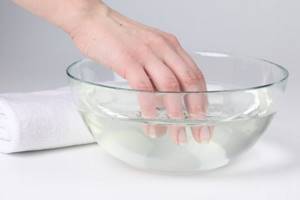
The procedure should be repeated every day, and if after four days there is no improvement, then a doctor’s examination is necessary. Baths with potassium permanganate also have a beneficial effect on the nail. The solution should be slightly pinkish. They can be done for about ten to fifteen minutes, every day, and the inflammation will go away.
Compresses with aloe juice help. We take a cotton swab, tangle it with juice and apply it. Or use a plant leaf cut lengthwise. A good solution would be baths with oak bark or chamomile. Honey cake is often used in folk medicine:
- Take 15 g of honey, add flour, mix so that you get a flat cake.
- First you need to disinfect the area of skin that is affected, and then apply the cake.
- The cake should be fixed.
- It is removed after twelve hours.
You can try treatment with herbs such as horse sorrel, plantain and St. John's wort. To do this, prepare the mixture:
- Take fresh leaves of the above plants and chop them finely.
- It should be a paste. We apply it to the affected area and secure it with a bandage.
Inflammation of the cuticles on the hands is often treated with a bath with St. John's wort. In this case, it is worth brewing 50 g of herb, fresh or dry, in boiling water (200 g). It is recommended to hold the infusion for at least thirty to forty minutes. The finger on which inflammation has formed is held for a quarter of an hour.
Surgical intervention
There are situations when ointments and traditional recipes are not able to stop the rapid development of infection. In this case, you will have to go to the clinic. They know how to help if your finger gets inflamed after a manicure. The surgeon will be able to explain in detail what to do to the patient. Most likely you will need to open the abscess and remove the contents.
During the procedure, the doctor will remove the necrotic epidermis using local anesthesia. Then he will wash the wound and examine its bottom. The doctor must make sure that the purulent contents are completely removed. After this, he will apply an aseptic dressing and, if necessary, drainage.
The patient will be prescribed antibiotic therapy. A few days after the procedure you will need to come for an examination. If the wound is clean, no further treatment will be required.
Drug treatment
In case of inflammation, the attending physician can often prescribe special ointments that relieve all symptoms of the disease. Let's look at the most popular ones.
Gentamicin ointment
The product is used three to four times a day. Treatment lasts from five to ten days.
Bacitracin ointments
A fairly common remedy with almost no side effects. It is recommended to use the ointment for five to ten days.
Bactroban
This ointment contains mupirocin, a substance with significant antibacterial properties. The product helps with severe inflammation. It is applied 2-3 times a day. The treatment period is the same as in the case of other ointments.
Ciclopirox
This ointment is used if fungi are the cause of inflammation. Apply it for exactly a month, no more than twice a day.
Vishnevsky ointment
This product is applied to a cotton pad, applied to the damaged area and secured with a bandage. Treatment works best before bedtime. The ointment is absorbed overnight, relieves various types of redness and draws out pus.
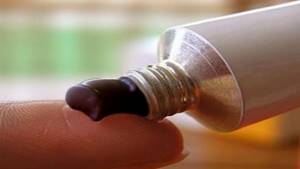
Cuticle inflammation on the hands can be cured with tablets. For example, we calculate the dosage of Amoxicillin in two ways:
- 500 mg / 125 mg – no more than 3 times a day;
- 875 mg/125 mg – 2 times a day.
The treatment period is about seven days. People suffering from kidney failure should calculate their individual dosage with their doctor.
Felon
All of the above symptoms most often accompany a disease such as panaritium. This is an acute inflammation of the tissues of the finger. It can develop on both the arms and legs. Most often it appears after a manicure, when accidental cuts and microtraumas allow infection to enter the body. Infection is caused by streptococcal, staphylococcal, enterococcal or mixed infection.
In most cases, it is felon that threatens a woman whose finger becomes inflamed after a manicure. What to do to protect yourself from this problem worries many people. The use of sterile instruments, as well as the professionalism of a manicurist, can minimize the risk of infection. If you manage to avoid cuts during the procedure, the gates to infection will not open.
Panaritium is dangerous because, in addition to the upper layers of the dermis, it can also affect the deep ones. It can affect joints, tendons and bone tissue. In advanced cases, the only way to stop the infection is amputation. Therefore, it is very important to treat the pathology in a timely manner.
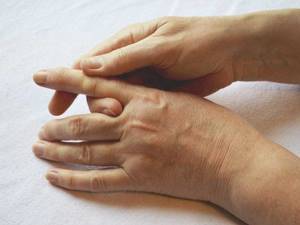
Preventive measures
To avoid a similar illness in the future, you must follow safety precautions:
- It is advisable to disinfect manicure instruments.
- If during a manicure the cuticle area is accidentally damaged, it should be immediately treated with an antiseptic solution.
- You should always have nourishing and softening products for the cuticle on hand.
- It is useful to do vitamin baths for your hands from time to time.
- When contacting household chemicals, use gloves.
Nail fungus
Fungi can be transmitted through household items. These can be not only washcloths or towels, but also door handles and telephone handsets. But most often they are transmitted through manicure tools. Statistics show that among all nail pathologies, fungi occupy a leading position. The processing of tweezers and scissors in salons is at least somehow monitored. But the condition of the files, on which infection can settle, leaves much to be desired.
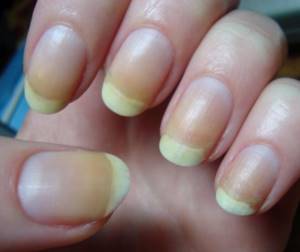
Most often, nail fungus is discovered after a manicure by girls who regularly get extensions done. At first after infection, the pathology does not manifest itself in any way. Nails may become more brittle, but under a layer of acrylic or gel this is not easily noticeable. Then the color of the plate begins to change, it becomes yellow-brown, white or greenish. The nail may thicken and change shape.
Toxins released by the fungus poison the body. The danger of infection is that it can quickly spread to all healthy nails. Therefore, the key to successful treatment is timely consultation with a doctor. If your hands itch after a manicure, this may be the first symptom of a fungal infection.
Prevention of nail diseases
Everyone knows that it is easier to prevent a disease than to treat it. But in everyday life people are too careless. They easily trust their health to professionals from a beauty bar or the nearest beauty salon, without checking the sterility of the instruments. Because of this, a situation arises when a finger suddenly becomes inflamed after a manicure. Everyone probably knows what to do to protect themselves. Unfortunately, this knowledge is rarely used in real life.
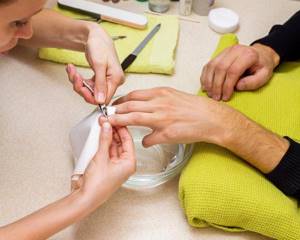
To avoid troubles and preserve your health, you should strictly monitor the master’s compliance with the following rules:
- The manicure table must be perfectly clean. Before starting to serve a new client, the technician must wash and disinfect his hands. The client should do the same.
- The manicure bath should be wrapped in a clean plastic bag. It is changed before each client.
- Tools must be packaged in a kraft paper bag, in which they are processed in a dry-heat oven. They should only be opened in front of the client.
- Files must be kept in an ultraviolet sterilizer. They should be taken out in front of the client.
- You can protect yourself from all risks if you bring your own set of instruments to the procedure.

